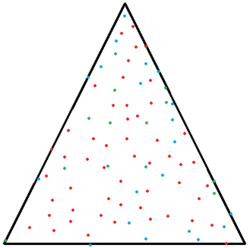Pointed Pointy Triangle (My bad sense of naming things)
 If the average distance from a point randomly selected in the unit equilateral triangle to its center equals
where
and
are positive integers with
being square-free. Find
.
If the average distance from a point randomly selected in the unit equilateral triangle to its center equals
where
and
are positive integers with
being square-free. Find
.
You might also like this
The answer is 23.
This section requires Javascript.
You are seeing this because something didn't load right. We suggest you, (a) try
refreshing the page, (b) enabling javascript if it is disabled on your browser and,
finally, (c)
loading the
non-javascript version of this page
. We're sorry about the hassle.
Let the unit triangle, Δ A B C , be centered on the origin, O . Let it be rotated such that point A is located at ( 6 3 , 2 1 ) , point B is located at ( 6 3 , − 2 1 ) , and point C is located at ( − 3 3 , 0 ) . The right side of the triangle will be the line x = 6 3 . In polar form, this is r = 6 3 sec θ .
Now consider Δ O A B bound by the lines θ = − 3 π , θ = 3 π , and r = 6 3 sec θ . The area of this triangle is B = 1 2 3 .
The distance from the origin to any point in Δ O A B will be the value of r for that point. Without loss of generality, we can conclude that the average distance from the origin to a point in Δ O A B is the same as the average distance from the origin to any point in the unit triangle, Δ A B C . We can calculate this average distance using the double integral:
B 1 − 3 π ∫ 3 π 0 ∫ 6 3 sec θ r d A
4 3 − 3 π ∫ 3 π 0 ∫ 6 3 sec θ r 2 d r d θ
1 8 1 − 3 π ∫ 3 π sec 3 θ d θ
This evaluates to 1 8 ln ( 2 + 3 ) + 2 3 .
a = 2 , b = 3 , and c = 1 8 . Therefore, a + b + c = 2 + 3 + 1 8 = 2 3 .